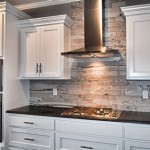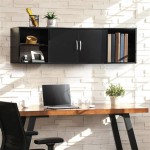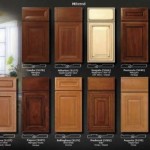How To Clean Sticky Grease Off Top Of Kitchen Cabinets
Kitchen cabinets, especially those on top, often accumulate a layer of sticky grease, dust, and grime. This buildup is a result of cooking byproducts, airborne particles, and general kitchen activity. Neglecting this issue can lead to a hardened, difficult-to-remove residue that detracts from the overall appearance of the kitchen. Regular cleaning is essential not only for aesthetics but also for maintaining a hygienic cooking environment. The following provides a detailed guide on how to effectively clean sticky grease off the top of kitchen cabinets.
Understanding the Problem: Grease Composition and Accumulation
The sticky substance found on top of kitchen cabinets is primarily composed of grease molecules released during cooking. These molecules, often in the form of vapors and aerosols, become airborne and eventually settle on surfaces. Over time, these deposits attract dust, dirt, and other particles, creating a sticky, tenacious layer. The composition of this layer can vary depending on the types of cooking done in the kitchen. For example, frying often releases more grease than boiling or steaming. The type of oil used, the frequency of cooking, and the effectiveness of the kitchen ventilation system all play a role in the accumulation rate and the overall stickiness of the grime.
Factors contributing to the difficulty in removing this buildup include the hardening of the grease over time and the chemical reactions that occur when grease interacts with other substances in the air. The longer the grease remains untouched, the more difficult it becomes to dissolve and wipe away. Furthermore, the porous nature of some cabinet materials can allow grease to penetrate deeper into the surface, making it even more challenging to remove.
Essential Tools and Materials
Before commencing the cleaning process, it is crucial to gather the necessary tools and materials. Having everything prepared in advance will streamline the process and improve efficiency. The following is a comprehensive list of recommended items:
- Cleaning Solutions: Options include dish soap, baking soda, vinegar, commercial degreasers, and citrus-based cleaners.
- Spray Bottles: For applying cleaning solutions evenly.
- Microfiber Cloths: These are excellent for wiping surfaces without leaving streaks or lint.
- Scrub Brushes: Soft-bristled brushes are ideal for agitating grease without damaging cabinet finishes.
- Sponges: For general cleaning and wiping.
- Scrapers (Plastic): Useful for removing stubborn grease deposits without scratching surfaces.
- Warm Water: An essential component for diluting cleaning solutions and rinsing surfaces.
- Rubber Gloves: To protect hands from harsh chemicals and grease.
- Eye Protection: Safety glasses or goggles to prevent splashes from entering the eyes.
- Step Stool or Ladder: To safely reach the top of cabinets.
- Drop Cloth or Old Sheets: To protect countertops and floors from drips and spills.
- Old Toothbrush: For cleaning hard-to-reach areas and crevices.
Step-by-Step Cleaning Procedures
The following provides a detailed, step-by-step guide on how to effectively clean sticky grease off the top of kitchen cabinets. This process involves preparation, cleaning, and restoration to ensure the cabinets are thoroughly cleaned and protected.
Step 1: Preparation. The first step involves preparing the work area. Begin by covering countertops and floors with a drop cloth or old sheets to protect them from drips and spills. Ensure adequate ventilation by opening windows or turning on the kitchen exhaust fan. Put on rubber gloves and eye protection to safeguard hands and eyes from cleaning solutions and potential splashes.
Step 2: Dry Cleaning (Optional). If the grease buildup is particularly thick, consider removing loose dust and debris with a vacuum cleaner equipped with a brush attachment. This will prevent the dust from turning into mud when wet cleaning begins. Alternatively, a dry microfiber cloth can be used to gently wipe away loose particles.
Step 3: Choosing and Applying a Cleaning Solution. Several effective cleaning solutions can be used to tackle sticky grease. The choice of solution will depend on the severity of the grease buildup and the type of cabinet finish.
Option 1: Dish Soap and Warm Water. A mixture of dish soap and warm water is a mild yet effective cleaning solution for light to moderate grease buildup. Mix a few drops of dish soap into a bowl of warm water. Apply the solution to the cabinets using a sponge or microfiber cloth, ensuring the surface is thoroughly wetted. Allow the solution to sit for a few minutes to loosen the grease.
Option 2: Baking Soda Paste. Baking soda is a natural abrasive that can help to remove stubborn grease. Create a paste by mixing baking soda with a small amount of water until a thick consistency is achieved. Apply the paste to the affected areas and gently scrub with a soft-bristled brush or sponge. Be cautious when using baking soda on painted surfaces, as excessive scrubbing can potentially dull the finish.
Option 3: Vinegar Solution. Vinegar is a natural degreaser and disinfectant. Mix equal parts of white vinegar and warm water in a spray bottle. Spray the solution onto the cabinets and let it sit for several minutes. Wipe away the loosened grease with a clean microfiber cloth. Vinegar can have a strong odor, so ensure adequate ventilation.
Option 4: Commercial Degreaser. For heavy-duty grease buildup, a commercial degreaser may be necessary. Follow the manufacturer's instructions carefully, as some degreasers can be harsh and may damage certain cabinet finishes. Always test the degreaser on an inconspicuous area first to ensure it does not cause discoloration or damage.
Option 5: Citrus-Based Cleaner. Citrus-based cleaners contain natural solvents that effectively dissolve grease. These cleaners are generally less harsh than chemical degreasers and have a pleasant scent. Apply the cleaner to the cabinets, allow it to sit for a few minutes, and then wipe away the grease with a clean cloth.
Step 4: Scrubbing and Agitation. After applying the cleaning solution, use a soft-bristled brush or sponge to gently scrub the affected areas. Pay particular attention to areas with heavy grease buildup. For stubborn deposits, a plastic scraper can be used to carefully remove the grease. Avoid using metal scrapers, as they can scratch the cabinet finish. Use an old toothbrush to clean hard-to-reach areas, such as corners and crevices.
Step 5: Rinsing. After scrubbing, thoroughly rinse the cabinets with clean, warm water to remove any remaining cleaning solution and loosened grease. Use a clean sponge or microfiber cloth to wipe away the water. Ensure that no residue from the cleaning solution remains on the cabinets, as this can attract dust and grime.
Step 6: Drying. Dry the cabinets thoroughly with a clean, dry microfiber cloth. This will prevent water spots and streaks from forming on the surface. Ensure that all moisture is removed, especially from corners and crevices.
Step 7: Polishing (Optional). To restore shine and protect the cabinet finish, consider applying a furniture polish or wood cleaner specifically designed for kitchen cabinets. Follow the manufacturer's instructions carefully. This step is particularly beneficial for wooden cabinets as it helps to moisturize the wood and prevent it from drying out.
Step 8: Prevention. After cleaning, implement measures to prevent future grease buildup. Regular cleaning is key; aim to wipe down the tops of cabinets every 1-2 weeks to prevent grease from accumulating and hardening. Improve kitchen ventilation by using the exhaust fan whenever cooking, especially when frying or sautéing. Consider placing parchment paper or shelf liners on top of the cabinets to create a barrier against grease and dust. These liners can be easily replaced when they become soiled, minimizing the need for extensive cleaning.
Addressing Specific Cabinet Materials and Finishes
The cleaning approach may need to be adjusted based on the material and finish of the kitchen cabinets. Different materials react differently to cleaning solutions, and some finishes are more delicate than others. Understanding the specific requirements of each type of cabinet is crucial to avoid damage.
Wood Cabinets: Wood cabinets are susceptible to water damage and drying. Avoid using excessive water when cleaning and always dry the cabinets thoroughly. Use wood-specific cleaners and polishes to maintain the wood's moisture and prevent cracking. Test any cleaning solution on an inconspicuous area before applying it to the entire surface.
Laminate Cabinets: Laminate cabinets are relatively durable and easy to clean. However, avoid using abrasive cleaners or scrub brushes, as these can scratch the surface. A mild dish soap and warm water solution is typically sufficient for cleaning laminate cabinets. Ensure that the edges of the laminate are properly sealed to prevent water from seeping underneath.
Painted Cabinets: Painted cabinets can be prone to chipping and peeling if not cleaned carefully. Avoid using harsh chemicals or abrasive cleaners. A gentle dish soap and warm water solution is usually the best option. Use a soft microfiber cloth to wipe the surface and avoid excessive scrubbing. Touch up any chips or scratches with paint to prevent further damage.
Glass-Front Cabinets: For glass-front cabinets, use a glass cleaner to clean the glass panels. Avoid spraying the cleaner directly onto the cabinet frame, as this can damage the finish. Spray the cleaner onto a microfiber cloth and then wipe the glass. Pay attention to fingerprints and smudges to maintain a clear and polished appearance.
Tips for Maintaining Clean Kitchen Cabinets
Maintaining clean kitchen cabinets involves adopting a routine cleaning schedule and implementing preventive measures. The following are some tips to help keep kitchen cabinets clean and free from sticky grease buildup:
- Regular Wiping: Wipe down the cabinets regularly with a damp microfiber cloth to remove dust and minor spills. This will prevent grease and dirt from accumulating and hardening.
- Immediate Spill Cleanup: Clean up spills immediately to prevent them from drying and becoming difficult to remove. Use a suitable cleaning solution for the type of spill and cabinet material.
- Proper Ventilation: Use the kitchen exhaust fan whenever cooking, especially when frying or sautéing. This will help to remove grease vapors and prevent them from settling on surfaces.
- Protective Liners: Place parchment paper or shelf liners on top of the cabinets to create a barrier against grease and dust. These liners can be easily replaced when they become soiled.
- Decluttering: Keep the countertops and cabinet surfaces clutter-free to make cleaning easier. Remove unnecessary items that can collect dust and grease.
- Professional Cleaning: Consider hiring a professional cleaning service periodically for a thorough cleaning of the kitchen cabinets and other areas.
By following these guidelines, maintaining clean and grease-free kitchen cabinets becomes a manageable task, contributing to a more hygienic and aesthetically pleasing kitchen environment.

How To Clean Sticky Grease Off Kitchen Cabinets

How To Remove Grease From Kitchen Cabinets 3 Methods Bob Vila

How To Clean Sticky Grease Off Kitchen Cabinets Ovenclean

Clean Sticky Grease Off Kitchen Cabinets In 5 Mins Or Less Torera George

How To Clean The Top Of Kitchen Cupboards 4 Simple Steps Everyday Old House

Clean Sticky Grease Off Kitchen Cabinets In 5 Mins Or Less Torera George

How To Clean Sticky Grease Off Kitchen Cabinets

How To Remove Greasy From Kitchen Cabinets Home Cleaning Tips

How To Clean Sticky Wood Kitchen Cabinets Easily Infinity

How To Clean Sticky Grease Off Your Kitchen Cabinets
Related Posts








